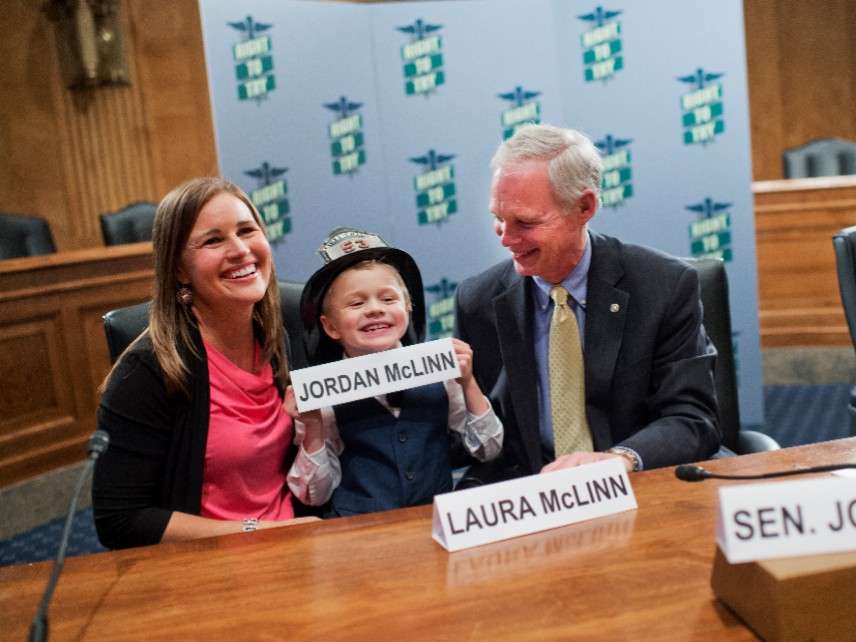'Right to Try' Bill Fails, Despite Concessions
"The House will not let this be the end," Majority Leader Kevin McCarthy said Tuesday night.

House Republicans failed yesterday to garner the votes they needed to pass a heavily modified version of the Senate's "Right to Try" bill. The legislation would have brought the U.S. one step closer to allowing terminally ill patients more freedom to test unapproved pharmaceutical products.
The House needed a two-thirds majority to pass the bill, as Republicans had suspended the rules in order to prohibit amendments being added on the House floor. The bill failed to reach that threshhold; the final tally was 259–140.
Right-to-try laws create a legal mechanism for patients and their doctors to request experimental treatments without first being enrolled in a clinical trial or getting permission from the Food and Drug Administration (FDA). Thirty-eight states have passed such bills, but until federal law changes no pharmaceutical company has an incentive to operate outside the FDA's purview.
Under the most recent House version of the bill, introduced by Energy and Commerce Committee Chairman Greg Walden (R-Ore.) and Health Subcommittee Chairman Michael C. Burgess (R-Texas), licensed physicians would be able to request a drug from the company that makes it so long as the drug had passed Phase I clinical trials. The bill does not require drug application sponsors or manufacturers to provide the drug. If they do opt to provide the treatment to a physician, the drug maker would be responsible for reporting the transaction to the FDA.
Walden and Burgess announced on March 10 that they'd added several others layers of regulatory compliance atop the more loosely written Senate bill that passed last August. Specifically, Walden and Burgess say their version of the bill would:
- establish a robust informed consent to access unapproved drugs;
- specify that any unapproved drug being used must have an active FDA application and not be the subject of a clinical hold by the FDA;
- require the sponsor and manufacturer to notify the FDA after they make an unapproved drug available to an eligible patient;
- guard patients from purposefully misbranded or mislabeled drugs;
- provide liability protections for participating manufacturers, sponsors, physicians, clinical investigators, and hospitals unless there is reckless or willful misconduct, gross negligence, or an intentional tort;
- obligate sponsors and manufacturers to report adverse events in real time to the FDA; and
- provide certainty to manufacturers about how the FDA will use patient outcomes when evaluating new drug applications.
These changes were intended to address several of the criticisms levied against right-to-try legislation by certain patient groups and medical ethicists, who have insisted throughout the debate that the FDA's "expanded access" program adequately serves terminally ill patients who have exhausted their options and want to try an experimental treatment. The NYU School of Medicine Working Group on Compassionate Use and Pre-Approval Access, for instance, has argued that because the FDA approves 99 percent of expanded access applications, there's no reason to cut the agency out of the process.
The House bill sought to strike a compromise by requiring doctors and drug manufacturers to notify the FDA of adverse events in real time, and by allowing the FDA to take those events into consideration when reviewing drug applications. Nevertheless, Democratic leaders in the House led a charge against the bill.
In February, dozens of patient groups asked Congress to vote down the bill, arguing that the recently passed Food and Drug Administration Reauthorization Act had already helped streamline the Institutional Review Board process and empowered the FDA to make clinical trials more inclusive. (Patients who wish to access an experimental treatment either under the FDA's current program or the House version of the Right to Try bill would first need to be rejected for a clinical trial.)
Proponents of right to try, which include many libertarian organizations as well as many patient groups, say that even though the FDA's application process for compassionate use has been simplified in the last decade, it may still be arduous enough to deter terminally ill patients and their doctors from applying.
"If 99 percent of requests are approved, what's hidden in that number—assuming it's true—is how many requests are never made because of how many doctors don't have the time, resources, or willingness to build a case," says Robert Graboyes, a health care researcher at the Mercatus Center.
Other proponents of right to try have argued that the commonly accepted idea that patients have a "right to die"—to intentionally take drugs that will speed death, or to refuse treatment for a terminal illness altogether—applies to unapproved therapies as well.
As noted above, the House version of the law would require any drug used have gone through at least phase I of an FDA clinical trial. Phase I is intended to provide baseline evidence of safety by determining the maximum dose that can be administered to a human patient without dangerous side effects. Phase I is not intended to assess how well a drug works (though it sometimes provides a glimpse).
The House version of the bill also limits eligibility to patients suffering "a disease or condition in which there is reasonable likelihood that death will occur within a matter of months; or a disease or condition that would result in significant irreversible morbidity that is likely to lead to severely premature death." The Senate version of the bill applies to patients with "life-threatening" illnesses, which the FDA argued was too broad a category.
House Republicans declared Tuesday that they would attempt to revive the bill. "The House will not let this be the end," Majority Leader Kevin McCarthy said in a statement. "We will try again, pass legislation, and bring hope to those whose only desire is the right to try to live."
Reason.tv profiled the Right to Try movement back in 2015:


Show Comments (67)